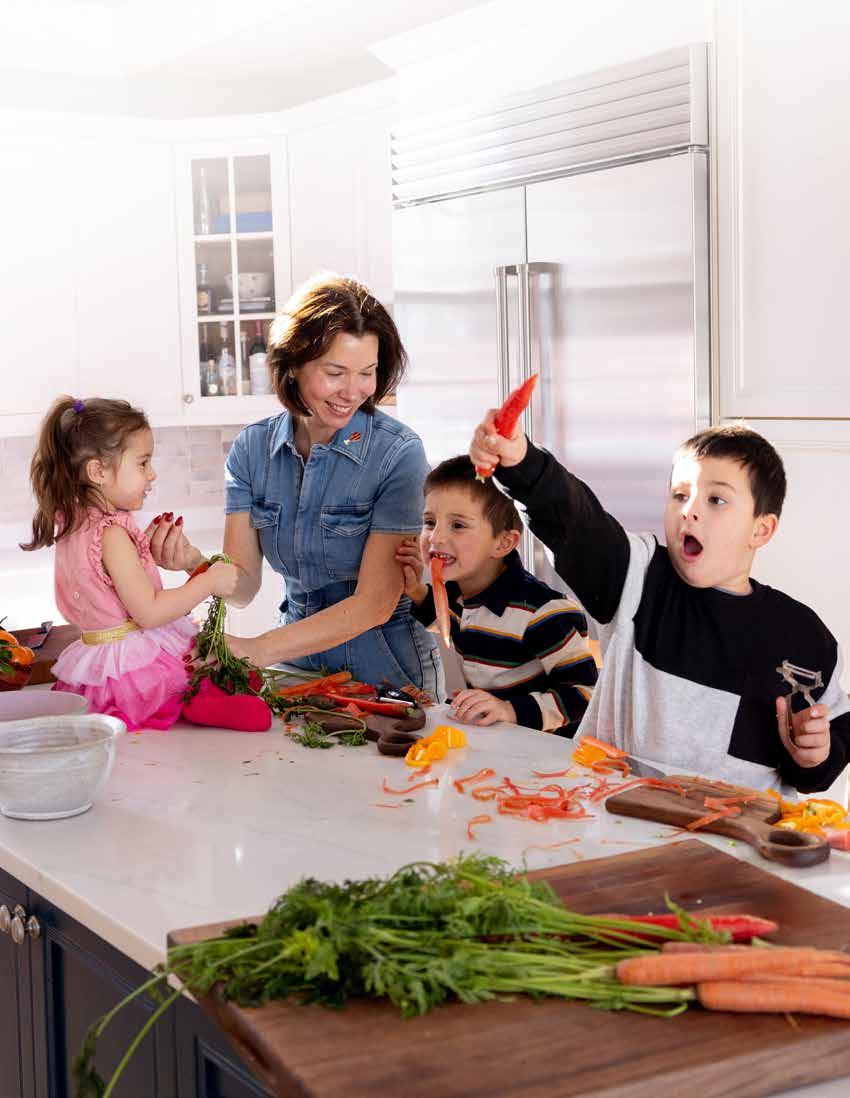
SPRING 2024 56 The Next Generation • Kids in the Kitchen A member of Edible Communities Celebrating the Abundance of Local Foods in Southern Wisconsin
II • SPRING 2024 VISITSHEBOYGAN.COM ENJOY A OR SURF OFF THE IN SHEBOYGAN WISCONSN HOME OF 3 SHEEPS BREWING EcÔÈuø
SPRING 2024
ISSUE
anew

6 STARTERS
In Season: Don't Toss the Tops by Marissa DeGroot & Christy McKenzie Goodbye, Grass. Hello, Edibles. by Erin Presley
10 NOURISH
Watercress: A Perennial Favorite by Laura Poe Mathes
14 FOODWAYS
Generational Farms: Flourishing into the Future by Megan Minnick
21 COOK AT HOME
Kids in the Kitchen by Lauren Rudersdorf
29 SEEDS OF CHANGE by Erica Krug
37 BACK OF HOUSE
Ahan: A Rising Restaurant Star by Marissa DeGroot



44 EAT & DRINK GUIDE Sponsored Content
46 SUPPORTERS
48 RECIPE INDEX
49 LAST BITE
EDIBLEMADISON.COM 1
Cover: Shaina Robbins Papach, co-owner of The Harvey House and Butter Bird, along with children Max, Charlie and Frances make preparing veggies for spring rolls look like a blast. Photo by SV Heart Photography.
Above: Shaina's middle child, Charlie, truly understands the joy of
•
“What earth will we leave for our children, and what children will we leave to our earth?” ― PIERRE RABHI 56

My daughter, Ollie, takes a big bite of cucumber after dunking it into a pile of mashed turnips and potatoes. I cheer her on like she’s an Olympic athlete, taking any opportunity to encourage adventurous eating with my toddler. This works a little too well as Ollie scoops up another glob of puree and offers it up to me. I take a nibble and smile since, after all, I’m a true believer in leading by example, even when it involves an odd combination of tastes and textures presented from a sticky hand.
As I’m pretending it’s the most delicious thing I’ve ever tasted, I can’t help but think that moments like these can play a small role in the future of a thriving local food system. It’s a future that will rely on the next generation of farmers, food service professionals, educators and eaters.
Examining the future of our food system is daunting and there is plenty to be concerned about. The average American farmer is 57½ years old and closing in on an uncertain retirement and succession of their livelihood. Increasingly, ultra-processed foods account for the majority of U.S. youths’ diets, and climate change will continue to escalate an already dire global food crisis.
The challenges are immense, but the stories in our spring issue, focused on “the next generation,” give me hope. I am inspired by Erica Krug’s article (page 29) on school gardens and the horticultural program at Oakhill Correctional Institution which spotlights how creativity and compassion can result in hands-on growing experiences for kids and second chances for those looking to reform. And in our "Kids in the Kitchen" recipes (page 21), I find comfort knowing that even a James Beard Award-winning chef like Tory Miller sometimes needs to hide veggies in meat and cheese.
In southern Wisconsin, there are so many ways to contribute to a thriving local food system, whether that’s planting more edibles in your yard this spring, as Erin Presley suggests (page 9), or grabbing dinner at a locally-owned restaurant like Ahan (page 37). At our house, we will continue to encourage the next generation of eaters and discover what unique culinary combinations Ollie comes up with next.

 Cheers, Marissa DeGroot, Managing Editor
Cheers, Marissa DeGroot, Managing Editor
Be sure to check out ediblemadison.com for exclusive online content, like Local UpStarts, a quarterly digital column that celebrates local entrepreneurs who have participated in the Wisconsin Alumni Research Foundation’s UpStart program, a free entrepreneurship program for women and people of color. This spring, we profile Sara Parthasarathy, co-founder and CEO of Flavor Temptations
2 • SPRING 2024
Above: Photo by SV Heart Photography
EDITOR’S LETTER

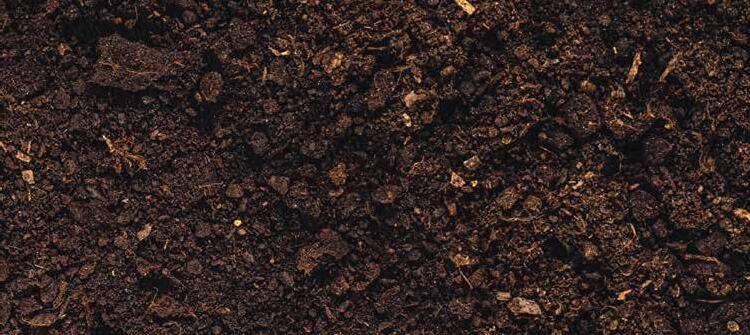
EDIBLEMADISON.COM 3 WILLY EAST 1221 Williamson St., Madison, WI Seeds, seedlings, soil, compost, seed-starting supplies and more! Fresh. Local. Organic. Yours! www.willystreet.coop Local and organic vegetable seedlings available this spring! WILLY WEST 6825 University Ave., Middleton, WI WILLY NORTH 2817 N Sherman Ave., Madison, WI Use code: MADISON24 Offer expires 05/31/24 15$ Off www.organicprairie.com YOUR NEXT ORDER OF $100 OR MORE Try a New Twist on a Classic Dish Our mouthwatering Meatball Pad Thai with Peanut Sauce is crafted with our 90/10 Organic Ground Beef. At Organic Prairie, we raise organic meat with sustainable farming practices on family farms. Find the recipe at www.organicprairie.com/blogs/recipes








MARISSA DEGROOT
Marissa feels fortunate to be a part of our local food system as the managing editor of Edible Madison as well as working for Vitruvian Farms, her husband Tommy's organic vegetable and mushroom farm. She loves raising their daughter, Ollie, and their team of fur babies on the farm in McFarland.
SUNNY FRANTZ
Sunny is an editorial and commercial photographer with a studio on the west side of Madison where she lives with her husband, their two kids and a tiny dog. She specializes in food and product photography and loves the opportunity it gives her to connect with the many wonderful businesses and entrepreneurs in Madison.
EMILY KAUFFMAN
Emily considers herself a forever learner. Whether it be through writing or food, hospitality or flowers, she is continually looking for new avenues to explore what care looks like in the world. Emily delights in watching things grow, pairing cottage cheese with apple butter and creating congenial spaces for gathering.
ERICA KRUG
Erica is a freelance writer from Madison. In addition to writing and helping to run youth writing summer camps, she also works for Rooted, a local nonprofit, where she supports statewide farm-to-school efforts. Erica loves gardening, swimming in cold lakes and playing Yahtzee.
MANAGING EDITOR
Marissa DeGroot
PUBLISHER
Christy McKenzie
BUSINESS DIRECTOR
Christy McKenzie
SALES DIRECTOR
Lauren Rudersdorf
LAYOUT & PRODUCTION
Nicole Peaslee
COPY EDITOR
Andrea Debbink
CULINARY ADVISOR
Christy McKenzie
SOCIAL & DIGITAL PRODUCER
Lauren Rudersdorf
ADVERTISING & SPONSORSHIPS
Lauren Rudersdorf laurenr@ediblemadison.com
DRIFTLESS REGIONAL SALES MANAGER
Kristen Wagner kristen@ediblemadison.com
CHRISTY MCKENZIE
Christy is the owner of Pasture and Plenty—a specialty market and deli, demonstration kitchen, and meal kit pick-up and delivery service. P&P gives the community access to healthy, locally-sourced meals and foods that make eating well and eating local easier every day. She works to create and connect community around issues of food equity, access and agency. She is the publisher of Edible Madison and a sometimes writer.
MEGAN MINNICK
Megan is a Madison native who recently traded her longtime career for fulltime fiction writing. When not typing away at a keyboard, she can be found wandering her garden, attempting to talk her kids into eating healthy food or curled up in a pool of sunshine with a cup of tea and a good book.
CONTACT US
Edible Madison 4313 Somerset Lane Madison, WI 53711 hello@ediblemadison.com
SUBSCRIPTIONS
Subscriptions are available beginning at $35 annually. Learn more at ediblemadison.com/subscribe
We want to hear your comments and ideas. To write to the editor, use the mailing address above or email hello@ediblemadison.com
NICOLE PEASLEE
Nicole is a graphic designer, photographer and artist from Madison. Her favorite things include off-trail hiking with her fiancé, Tyler, binging NYT Cooking videos and being a home chef, reading plenty of books and playing Dungeons and Dragons with her stepsons. She is also a co-founder of New Fashioned Sobriety, an alcohol-free community based in Madison which hosts monthly meetups and events. She aspires to someday photograph and design a cookbook for someone.
LAURA POE MATHES
Laura is a registered dietitian in private practice, focused on healing with real foods and herbs. She loves to spread knowledge and enthusiasm about great food, and teach traditional cooking and fermentation classes around the region. Originally from Missouri, Laura lives in Viroqua and now understands why cheese curds are a thing. She also loves to canoe, drink coffee and watch stand-up comedy.
Edible Madison is published quarterly by Forager Publishing, LLC. All rights reserved. No part of this publication may be used without written permission by the publisher. ©2024
Every effort is made to avoid errors, misspellings and omissions. If, however, an error comes to your attention, please accept our sincere apologies and notify us. Thank you.
VISIT US ONLINE AT EDIBLEMADISON.COM
4 • SPRING 2024
CONTRIBUTORS




ERIN PRESLEY
Erin manages the herb, woodland and pond gardens at Olbrich Botanical Gardens. Her interests include native woodland plantings, sedges, American ginseng, low-maintenance and drought-tolerant gardening styles, recycling coarse woody debris, and all things related to herbs, vegetables and cooking. Never shy when it comes to sharing the joy of gardening, she has appeared on the PBS series "Let’s Grow Stuff" and Wisconsin Public Radio’s "Garden Talk" and is a contributor to Fine Gardening magazine.
CRICKET REDMAN
Cricket is an avid gardener, artist and designer, and messy cook. By day she runs Cricket Design Works and was creative director and partner of Edible Madison from the beginning of the pandemic through 2023. In 1993, she moved to Madison for grad school at UW-Madison and fell in love with the snowy winters, the Driftless landscape and her now-husband and business partner, Phil.
LAUREN RUDERSDORF
Lauren is the voice behind the local food blog The Leek & The Carrot where she shares recipes and stories about life, food and farming. Before that, she owned Raleigh’s Hillside Farm, an organic CSA vegetable farm, with her husband, Kyle. She advocates for local farms, local food and cooking with the seasons. When she’s not writing or testing recipes in her sunny kitchen, she’s probably on a trail somewhere with her daughter, Lillyan.
SHARON VANORNY
Sharon is a Madison-area photographer who has one husband, one cat and one kid. She loves shooting editorials, headshots, weddings, events and families. The balance makes her heart happy. She also loves a wild card person and capturing a good wild card moment.





EDIBLEMADISON.COM 5
Sign up for our monthly newsletter The Beet to get the latest news and offerings at EDIBLEMADISON.COM on instagram @ediblemadison on facebook /ediblemadison Keep
your partner in local food. Downtown La Crosse, WI and Rochester, MN www.pfc.coop 7 days, 8 a.m.–9 p.m. Open to the public • Free parking Radishes, Stateline Produce Lime Springs, IA La Crosse: 67 miles Hare and Tortoise Farm Millville, MN Rochester: 23 miles
up with us between issues
by Marissa DeGroot and recipes by Christy McKenzie
In Season: Don't Toss the Tops
Whether it’s overwintered carrots or spicy radishes, spring in Wisconsin is replete with roots. Spring turnips and radishes can start showing up in markets as early as March, with carrots and beets appearing in late spring. While the roots are delicious roasted or raw, oftentimes their leafy tops end up in the compost bin.
But there’s no need to toss the tops! Designing dishes around these edible root tops can be both yummy and rewarding as you reduce your food waste.
Spring Turnip Greens
Hakurei turnips, commonly called spring or salad turnips, have greens that can be enjoyed raw or sautéed, just like the turnip root. Unlike storage turnips, the greens from spring turnips are mild and a little sweet.
Radish Leaves
Similar to the radish bulb, radish leaves carry a peppery bite. While most often used to make pesto, radish leaves can also be wilted and added to a variety of dishes, from stir fries to scrambled eggs.
Carrot Tops
Not only are carrot tops edible, they are packed with vitamins! These earthy greens are somewhere in between an herb and salad green so they work well anywhere you’d use parsley or Swiss chard.
Beet Greens
The beautiful stems and greens topping beetroots are filled with potassium and magnesium, making these leaves good and good for you. They can be used like most other leafy greens—raw in salads or smoothies or sautéed for a side dish.
Glazed Baby Carrots with Carrot-Top Pesto on Herb-Whipped Greek Yogurt
Serves 4-6
Prep time: 30 minutes
Cook time: 30 minutes
The perfect winter-into-spring recipe, this easy dish makes use of the whole carrot, root to top! Enjoy as a whole meal with a big slab of hearty sourdough or as a stand-out side.
INGREDIENTS
For Glazed Carrots:
2 bunches spring carrots, scrubbed, tops trimmed off and reserved for pesto
2 tablespoons olive oil
1 tablespoon melted butter
2 tablespoons honey
½ teaspoon kosher salt
¼ teaspoon cracked black pepper
For Carrot-Top Pesto:
2 bunches carrot-top greens (tops and not the woodier stems), rinsed and roughly chopped
½ cup mixed spring herbs (any combination of basil, mint, thyme, oregano, savory or parsley)
½ cup toasted hickory nuts or pepitas
2 cloves garlic
1 lemon, zested and juiced
¼ teaspoon crushed red pepper, or to taste
Pinch of salt
¼ cup olive oil
For Herb-Whipped Greek Yogurt:
4 ounces sheep feta
½ cup Greek yogurt
2 tablespoons carrot-top pesto
6 • SPRING 2024
DIRECTIONS
1. For the glazed carrots, preheat the oven to 425 degrees F. Line a 13x9-inch baking sheet with parchment paper.
2. Place the carrots on the baking sheet and toss with the olive oil, melted butter, honey, salt and pepper.
3. Roast the carrots in the preheated oven until golden and tender, about 20 minutes. Remove from the oven and set aside until ready to serve.
4. For the carrot-top pesto, place the carrot-top greens, herbs, nuts, garlic, lemon zest and juice, crushed red pepper and a pinch of salt into the bowl of a food processor. Pulse until well combined and all ingredients are about the same size. Then, with the food processor running, slowly drizzle in the olive oil. Remove from the bowl of the food processor and set aside until ready to serve.
5. To make the herb-whipped Greek yogurt, add the feta, Greek yogurt, and 2 tablespoons of the carrot-top pesto to the bowl of a food processor. Pulse until creamy and well combined.
6. To serve, spread the whipped yogurt in a ½-inch thick layer on a serving platter or on individual plates. Top the yogurt with the glazed carrots and spoon the pesto over the carrots.
More spring recipes available online including: Beet Green Chimichurri
Roasted Radish and Turnip Salad EDIBLEMADISON.COM/RECIPES
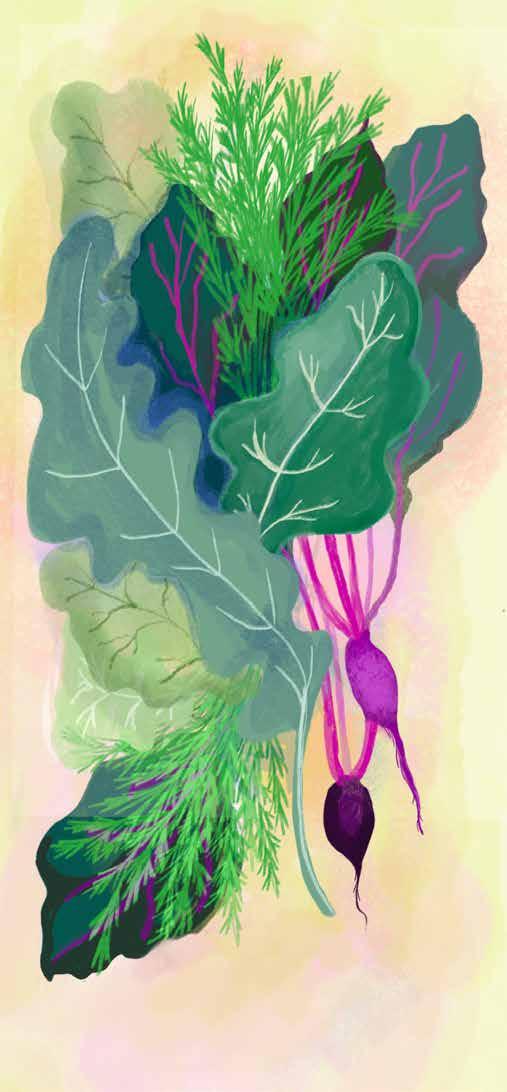
EDIBLEMADISON.COM 7
Greens in all their early season glory: carrot tops, beet greens, turnip and radish tops.
Illustration by Cricket Redman
by Erin Presley
Goodbye, Grass. Hello, Edibles.
Picturing the quintessential American yard brings forth images of vast, grassy lawns with weekends of mowing and combating weeds. But what if your usual yard work routine could instead produce a harvest of delicious goodies to grace your table? While I'm not suggesting you ditch the lawn entirely, there is a growing movement toward reimagining the yard into a more environmentally-friendly and abundant space. Whether you have an acre of sunny yard or a small, shaded corner of a condo, there are a variety of herbs and vegetables that can meld effortlessly into your existing garden spaces and habits, adding beauty and delivering rewarding harvests with minimal effort. With the growing season just around the corner, a few handy tips can help you incorporate edibles in every garden.

1. See the opportunities in challenging spots
Even spots that are difficult for growing ornamental plants can offer unexpected opportunities for well-selected edible plants to thrive.
Hot, cramped areas adjacent to driveways and entries are perfect for squeezing in attractive, droughttolerant Mediterranean herbs like rosemary, oregano and thyme, keeping them close at hand to add to marinades and salads.
Tuck in a salad garden cutting mix in partial shade where hostas and ferns do well. Baby greens still grow nicely in dappled sun and benefit from a break from summer heat when temperatures climb.
Save your sunniest spots, preferably near a hose spigot, for water and heat lovers like tomatoes, eggplant, peppers and cucumbers. When looking for garden locations to incorporate edibles, only two general conditions need to be avoided—deep shade and poor drainage. Most edible plants prefer
six or more hours of sun daily, while boggy or waterlogged conditions are hard to tolerate even for most ornamental plants and will result in stunted, poor-quality vegetables.
2. Go vertical
Existing vertical structures near your home such as downspouts, railings, and screening and utility fences can make perfect supports for rambling and climbing vegetables. These structures are usually sturdily built and well-anchored, making them better than temporary trellising materials for growing heavier vegetables like tomatoes or squash.
Imagine fast-growing, vigorous pole beans disguising an unloved chain-link fence with their delicate flowers and dangling pods. Scarlet runner beans are especially vibrant with flashy orange blooms, while the variety ‘Carminat’ offers slender 8-inch beans with a dramatic violet color. Brilliant red tomatoes are a perfect option for training on sunny balconies and fire escapes where the fruits benefit from ample sunlight and air circulation.

8 • SPRING 2024
Photos courtesy of Erin Presley

Homemade trellises and obelisks are also great for supporting climbing vegetables while adding vertical interest to traditional sunny perennial plantings. Using materials found around your yard or neighborhood, such as leftover building supplies or fallen branches, adds a sense of character and spontaneity. Squashes are particularly nice tucked into the landscape since their large yellow flowers are still visible from a distance. Try the adorable variety ‘Honey Bear’ which produces tasty small acorn squashes perfect for a single serving when halved and roasted.
3. Seek out varieties
adapted to smaller yards and containers
Delve into seed catalogs and plant lists from local growers to research edibles especially suited for your unique growing conditions. This is especially helpful if your edible landscape includes gardening in containers; in recent years, plant breeders have devoted increased attention to developing compact varieties that stay tidy in urban yards and containers. These varieties also frequently offer early ripening and increased disease-resistance, contributing to fulfilling harvests and attractive plants.

Burpee Seeds has a section of their website that’s dedicated to container vegetables, and searching online seed catalogs using keywords like “dwarf,” “container” or “miniature” can yield good options.
Also pay attention to plant varieties labeled with the blue-and-red “All-America Selections” badge, a national plant evaluation program that highlights particularly good performers across the US.
4. Be bold
Don't be afraid to get a little wild with the diversity of colors and textures that edible plants can offer! Flashy varieties of kale such as the sexy, dark purple ‘Redbor’ and ruffly white-and-green ‘Casper’ are favorites for edible landscaping, delivering generous harvests over a long season. I can't be without an adorable miniature eggplant like ‘Fairy Tale,’ with trusses of bite-size lilac- and cream-colored fruits perfect for sautéing or tossing on the grill. Even familiar herbs like basil offer a plethora of interesting options, from refined ‘Spicy Globe’ with its tiny leaves and compact habit perfect for tucking into window boxes, to the bold ‘Purple Ruffles’ which makes a dramatic splash mingling in planting beds.
Don’t be surprised when that splash ripples outside of your garden beds and into the street! Gorgeous herbs and veggies front and center are a surefire conversation starter for passersby who might recognize an old favorite or be intrigued by a colorful new variety. And what’s more fun than sharing a handful of luscious cherry tomatoes with the neighbor kids? Include a few extra bold, beautiful edibles in your garden plans this summer to reap benefits beyond your kitchen.
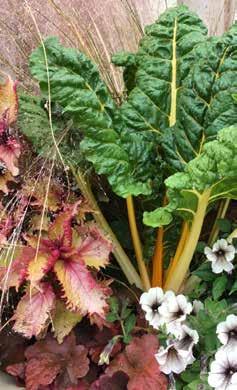
EDIBLEMADISON.COM 9
Left: A variety of herbs including sage, parsley, thyme and oregano thrive together in this tight space adjacent a sidewalk.
Middle top: Delicate 'Fairy Tale' eggplants make productive and beautiful container plants.
Middle bottom: A brilliant squash blossom reaches for the sun.
Right: Flashy Swiss chard mingles with coleus and petunias in this upscale container planting.
Watercress
A PERENNIAL FAVORITE

Coming upon a patch of watercress growing in the wild is a feast for the senses: a blanket of lush, bright green leaves covering a sweet, still spring or a babbling brook, waiting to be harvested and enjoyed by the lucky forager. On a particularly lovely spring day, you may even feel like you have discovered a fairy habitat, it can be just that magical and beautiful. Fortunately for those of us in southwest Wisconsin, this scene is not very hard to come by—watercress can be found abundantly, if you know where to look.
Wild watercress is a small, green leafy plant that grows, as you may have guessed, in water rather than soil. You may have seen it growing near roadsides as you drive—a small pool or stream with edges covered in green leaves is likely to be a place where watercress is growing. Watercress has a unique flavor that is a little bitter and spicy, like the kick found in mustard greens. This makes sense, as it is a brassica, the same family as mustard greens, as well as broccoli, cabbage and radishes. It can be eaten raw or cooked, and has a wide variety of culinary uses. It seems this wild green has been consumed for thousands of years,
and it is easy to see why: it grows vigorously and is fairly ubiquitous, easy to harvest, tastes delicious and is loaded with nutrients.
Like most wild foods and other vegetables in the brassica family, watercress is a nutritional powerhouse, providing vitamins, minerals and anti-inflammatory phytochemicals like quercetin, lutein (noted for eye health), polyphenols and glucosinolates—one of the compounds responsible for its distinctive flavor. Watercress also provides beta-carotene, vitamins C, K, E, and B6, thiamin, folate, calcium, iron, iodine and fiber, making it a delicious way to add nutrient density to your diet.
Watercress is a perennial that grows on the edges of freshwater sources that are spring-fed, such as streams and ponds, and can be found around the world. It originated in Europe and was brought here to be used for food, so watercress is not native to our area, despite its ability to thrive here. The young, more tender leaves are round and as the plants get older, the leaves grow into a longer, more oval shape. Watercress also has long, ten-
dril-like roots that grow into the water below the leaves. For the best quality watercress, carefully harvest with scissors or a harvesting knife above the waterline. Watercress can be harvested yearround, even in winter, though spring tends to be a much more enjoyable foraging experience for most folks—you could even look for some other goodies like nettles while you’re out there! The flavor also intensifies as the plants age and many prefer its flavor when it is young, before flowering.
Watercress can also be cultivated, and can often be found at co-ops and other grocery stores that stock local produce. If you are considering creating your own watercress patch, keep in mind that it can spread and can take over significantly. Do not plant watercress in rivers or streams, where it can damage native habitats. Cultivated watercress can be grown in wet, organically rich soils rather than water, which can help avoid further invasion. It is generally advised not to intentionally grow wild watercress at this point due to its invasive nature; there is plenty around, so try to enjoy some already growing in the wild!
10 • SPRING 2024
NOURISH LAURA POE MATHES
Because it grows in water, there are some unique considerations when it comes to harvesting and eating watercress. Starting with correct plant identification is essential, of course. Getting acquainted with watercress before foraging is a good idea. Find a reliable foraging book, workshop, or friend (or better yet, all three), to help ensure you are harvesting the correct plant and doing it with care for the land. It is considered an invasive species, so harvesting plenty to eat is usually just fine. Once you have a plant ID and permission to harvest squared away, it is very important to ensure the water source is pristine where the watercress is growing. If the water is contaminated, then the watercress will be as well. Look for watercress growing in potable water, away from agricultural and livestock areas and land that is prone to flooding (which can cause bacteria and parasites to harbor in the typically clean above-water leaves).
One notable food safety issue with watercress is liver flukes, a type of flatworm transmitted through food. Watercress is the primary source
Watercress is a perennial that grows on the edges of freshwater sources that are spring-fed, such as streams and ponds, and can be found around the world.
mustard greens in the Indian dish saag paneer, or the Ethiopian dish gomen. A light sauté with a bit of butter and salt can turn watercress into a delightful side dish, filling for omelets or as an addition to a very grown-up grilled cheese. Used in its raw state, fresh watercress will have a stronger flavor and can adorn any sandwich or salad, and is quite tasty on top of a bagel with lox and cream cheese. Its powerful flavor lends watercress to sauces, and it can be a great pop of flavor in oil-based sauces like pesto, chimichurri, salsa verde, zhoug, or green goddess dressing or any yummy green sauce, really.
Even when grown in clean water, there can still be food safety concerns with consuming watercress, particularly when raw, due to the nature of how it grows. Inspect your harvest for any critters or debris before consuming. If you have a compromised immune system, it is generally recommended that you only consume watercress that has been cooked. Cooked or raw, it is important to thoroughly wash any watercress before consuming to prevent food-borne illness.
of liver fluke infections in humans. These are killed through cooking, making cooked watercress very safe to eat. If harvested properly from clean sources, and especially early in the growing season, even raw watercress can be considered safe for most, except for those at high-risk for food-borne illness. For an even deeper dive into harvesting and preparing watercress (and liver flukes!) check out Alan Bergo’s Forager Chef website and Incredible Wild Edibles by Samuel Thayer, two experts in the field .
Watercress can add its peppery, bitter notes to many dishes and can be used alone or in a combination with other greens as well. If you are going to cook the greens, they are delicious in a springtime soup, used in place of or alongside
If you have not experienced eating or foraging for watercress, this may just be the spring you go wild and try something new. This is prime foraging time, and whether for its nutritional value, delightful flavor or just for the experience of harvesting your own food, I encourage you to get on your waders (or borrow a pair from your trout-fishing friend) and go on the hunt for some fresh watercress…who knows, maybe you’ll see a fairy or two (or make a new foraging friend) while you’re out there!

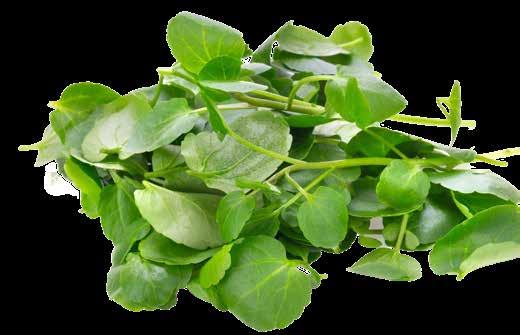
EDIBLEMADISON.COM 11
Watercress and Chèvre Stovetop Frittata
An impressive brunch dish or an easy weeknight meal, this stovetop frittata comes together quickly—as long as you have fresh watercress on hand, that is. Eggs are a perfect backdrop for its pungent flavor, and creamy chèvre joins the party to round it all out. Young watercress tends to resemble its cousin, arugula, in flavor profile. You can substitute arugula or mustard greens, or milder greens like nettles or spinach in this recipe if necessary.
Serves 6
Prep time: 15 minutes
Cook time: 25 minutes
INGREDIENTS
2 tablespoons butter
8 eggs
¼ cup whipping cream
½ teaspoon sea salt
1 pinch black pepper
2 cloves garlic, minced
1 tablespoon fresh dill (or other fresh herbs)
2 cups fresh watercress, thoroughly washed
1 cup chèvre (goat cheese)
Parmesan cheese for garnish

DIRECTIONS
1. In a 9-inch cast-iron skillet, heat the butter over medium heat.
2. While the butter melts, whisk together the eggs, cream, salt, pepper, garlic and dill until well mixed.
3. Add the watercress to the heated pan and sauté for 3-5 minutes in the butter until the watercress has wilted and reduced in volume by about half.
4. Add the egg mixture to the pan, gently stirring to just incorporate the watercress.
5. Dot the top of the mixture with the chèvre so it is evenly distributed across the top.
6. Turn the heat to low and cover the frittata with a lid. Let it cook for 15 minutes without stirring or opening the lid. After this time, the eggs should be set but not overcooked.
7. Turn off the heat and let the frittata sit for another 5 minutes, leaving the lid on to let the frittata continue to set without overcooking.
8. Remove the lid, garnish with freshly-grated Parmesan and slice to serve.
12 • SPRING 2024
Photo by Sunny Frantz
PIZZA WITH A PURPOSE
WED, APRIL 3 • 6PM • VIRTUAL EVENT
$35 • PIZZA KIT (SERVES 4) + VIRTUAL TICKET
FEATURING
Mo Cheeks of Bread & Justice and Pasture and Plenty
Let’s knead some dough, eat delicious pizza, and make a difference together. A portion of the proceeds will benefit urban agriculture and food security programs.
BROUGHT TO YOU BY

GROW TOGETHER IN THE GARDENS
This year, give the gift of learning at Olbrich, for yourself or for your friends and family.
Registration is open for classes through May 2024
LITTLE SPROUTS • GARDENING ENVIRONMENTAL EDUCATION
YOGA • ART CLASSES • AND MORE!
FOLLOW US!

Sign up here:
COOKIN G T O G ETHER!
OLBRICH.ORG
CLASSESFORALLAGES
by Megan Minnick
GENERATIONAL FARMS
Flourishing into the Future
What does it mean to be a multigenerational farmer?
There’s a privilege, of course, that comes with that designation. Many multigenerational farmers inherit their land rather than purchase it. They often have the benefit of lived experience and knowledge passed down over time, as well as established connections and revenue streams.
And it’s not just an advantage for the newest generation. As a farmer ages, it’s much easier to relax into retirement when there are children to hand things off to.
But there’s also a responsibility that comes with being a multigenerational farmer, a responsibility rooted in the land. These farmers are links in a chain between the past and present. They’re stewards of the fields and the legacies of their parents, grandparents and great-grandparents—and they’re also stewards for future generations.
CONNECTING THE PAST, PRESENT AND FUTURE
Joe Henry didn’t plan to take over his family farm. Growing up on his father’s seed-corn growing operation in the Village of Dane in the 1960s and ’70s, he learned how to farm, but he never imagined himself a farmer. He went away to college, majoring in finance. But when Henry inherited the farm in the late ’70s and the job market wasn’t promising, he decided to give farming a try. The timing wasn’t great. Within a few years, the farm crisis of the '80s hit, and Henry was faced with a choice: sell the land where his family had been living and farming since the 1940s, or dig deep and do what it took to make the farm profitable again.
He chose the latter path, and through hard work, perseverance and imagination the farm once again became successful. He married in 1985 and together with his wife, Liz, he made the farm a place where their children, Joe Z. and Jack could enjoy a childhood much like their father’s—
helping with the chores, cutting their own Christmas trees, playing with the farm dogs and living life to the fullest.
Fast-forward to 2008. Growing seed corn was still the farm’s mainstay, but Henry realized that he needed to diversify, both to ensure the farm would never again be in the position it had been in the ’80s and to create a more exciting facet to the business that might draw his sons back to farming. (Because, like their father before them, neither Joe Z. nor Jack imagined themselves as farmers.)
After some thought and a trip to Kentucky, Henry settled on a product that American grain farmers have been crafting to generate extra income since the eighteenth century: distilled grains, specifically bourbon.
And so, J. Henry & Sons bourbon was born.
But this isn’t just any whiskey. It’s not just the distilled essence of corn, wheat and rye. It’s more complex than that. In each bottle, there’s a blending of the past with the present and an intention for the future. To fully understand that we have to go back in time again, to 1946, when Henry’s dad Jerry first started farming in Dane.
From the 1940s through the ’60s, Jerry grew a unique type of hybridized red corn that was developed by breeders at UW–Madison. This corn hybrid, now considered an heirloom, has long since been abandoned by modern farmers. The quality of the red corn was superior, but the stalks were weak, making it inefficient to harvest, and the starch-to-oil ratio made it much slower to dry than more modern varieties. In fact, by 2008 when Henry decided to try his hand at distilling, the red corn and all its seed stock had completely disappeared. It didn’t exist. But what did exist were the parent inbreds the breeders had used to create the red corn. Those were locked away in the UW–Madison seed vault.
Henry remembered the red corn from when he was a boy, and with the decision to distill bourbon came the decision

14 • SPRING 2024 FOODWAYS
Photos courtesy of J. Henry & Sons
to reach into his past and revive the heirloom grain. This meant repropagating or redeveloping the hybrid corn from the original parent inbreds, then growing it in larger and larger quantities until enough seed existed to maintain a steady supply for making bourbon. A similar process was used for the wheat and rye. Even now, the Henrys must save their own seed year after year.
The grains in the Henry’s bourbon connect Joe and his sons to their family’s past, but it doesn’t end there. Over the last five years, they worked with corn breeders to improve the heirloom by strengthening the plant’s stalks. This effort used modern techniques to make the corn more financially sustainable to grow and harvest, without compromising the quality or nature of the grain.
The Henrys are also prioritizing sustainable farming techniques such as crop rotation, the use of cover crops, and erosion control in order to keep the land healthy for future generations. They’re honoring and preserving their past, while drawing on the technologies of the present to create a business that will flourish into the future.




EDIBLEMADISON.COM 15
Top left: This heirloom red corn grown on Henry Farms helps connect the Henrys to their family's past.
Top right: Brothers Jack and Joe Z. Henry (now a Master Blender) are the next generation to carry on the family farming and whiskey business.
Bottom right: Henry Farms, around 20 miles north of Madison, is where the family has been raising heritage red corn, rye and wheat for over 50 years.
Bottom left: Joe and Liz Henry at their bourbon tasting room and farm in Dane.
PIVOTING FORWARD
While Michael Dolan’s college classmates were saying they would never go back to the family farm, he was considering abandoning his chemistry studies to become the seventh generation to work his family’s Spring Green farm. Dolan did stay and earn his degree, but shortly after graduation he took his place at Seven Seeds Farm, a highly diversified pastured livestock and cropping operation.
Dolan’s family has farmed their property for more than 150 years. It originally began as a dairy farm, then during Dolan’s childhood his grandmother rented out the land for corn, bean and hay rotation—mono-crops planted and harvested annually. That all changed when Dolan’s parents, Greg and Lea, bought the land with a dream of growing their own food.
“My parents had a mission to raise their own food back in 2007,” says Dolan. “We just started with a little herd of 14 beef cows and a couple pigs. Now we’re feeding a whole community!”
Dolan, along with his wife, Chloe, have built upon his parents’ dream and are now turning an even greater focus towards the health of the land—using methods like intensive, rotational grazing and silvopasture (planting trees within the pasture) to reduce erosion and sequester carbon.
These practices are doing more than just protecting the land, they are also yielding some of the highest quality, certified organic beef, pork and chicken, used by some of southern Wisconsin’s top chefs and available through an online and on-site store in Spring Green.
Dolan’s brother has now joined the farm full-time after graduating from Iowa State University, helping Dolan to adjust, pivot and innovate into the future. Most recently, they planted 12,000 fruit and nut trees, as well as four acres of hazelnuts throughout the farm.
And while it feels like they are just getting started, Dolan and his family are aware of the diligent financial planning needed to ensure the eighth generation can carry on the family business.
“For a lot of farmers, their retirement is the farm itself— it’s their equipment, it’s their land,” says Dolan. “If we can create a system in which we’re able to pass down the farm with minimal debt service to our kids, that’s always our goal. It’s made it seven generations so far, so we don’t want to be the generation to break that.”
LEAVING A LEGACY
Earl Doudlah passed on much more than just the family farm to son Mark. He shared a mindset to always “think outside of the box.” This philosophy spurred Mark, a sixthgeneration farmer, to reinvent how they grew food at Doudlah Farms.
For generations, the Doudlah family had been conventional farmers—using chemical fertilizers to promote plant growth and pesticides to get rid of weeds and pests. When Mark began working on the 1,650-acre family farm in Evansville, he too learned how to grow sunflowers, corn and beans with pesticides.
That all changed when Earl was diagnosed in 2008 with mantle cell lymphoma, a form of cancer with higher rates among conventional farmers. Doctors said it was likely caused by years of exposure to pesticides, herbicides, fungicides and degreasers. Earl lost his fight with cancer in 2011. It was a loss that left Mark without his hero and mentor but also propelled him to make a change that would profoundly impact the future of Doudlah Farms.
“I knew I had to make changes and these changes had to be now,” says Doudlah. He dedicated 40 acres of the family farm to trial farming organically. It didn’t go well. All of the experience and knowledge passed down through the generations hadn’t prepared Doudlah for challenges like weed management and caring for soil health.


16 • SPRING 2024
This page: 4th generation Ruby Mickelson and 2nd generation Laura Mickelson in front of the family barn and granary in Spring Green in the late 1930s.
Middle top: The barn at Seven Seeds Farm, a regenerative farm raising organic grass-fed beef, pork and chicken.
Middle bottom: Four generations currently live and work at Seven Seeds Farm.
Photos courtesy of Seven Seeds Farm and Doudlah Farms
“WE JUST STARTED WITH A LITTLE HERD OF 14 BEEF COWS AND A COUPLE PIGS. NOW WE’RE FEEDING A WHOLE COMMUNITY!”
— Michael Dolan, Seven Seeds Farm






Bottom right: The Doudlahs cultivating organic beans on their Evansville farm.
Doudlah pushed through the early struggles, embracing his father’s mantra to “think outside of the box.” He threw himself into learning how to turn the conventional family farm into one embracing biodynamic, organic and regenerative growing methods. Doudlah was seeking a better future for not only his family and farm but the community at large.
Mark, along with wife Lucy, son Jason, and daughter Emily, now grows certified organic beans, seeds and grains with their products available across the Midwest and East Coast. Jason plans to study agriculture and engineering in college, preparing himself to be the seventh generation to carry on the Doudlah Farm legacy—a legacy now steeped in concern and care for the health of the environment and people.
EDIBLEMADISON.COM 17
Top left: Organic white popcorn, grown on Doudlah Farms, ready to be packaged and sold across Wisconsin and eastern United States.
Top right: Mark Doudlah along with son Jason, the 6th and 7th generation of farmers.
Bottom left: Earl Doudlah, Mark's father, as a child growing up on the family farm.















18 • SPRING 2024 Open Wed-Sun, 8 am - 1 pm 1924 Fordem Avenue, Madison One of a kind small bakery specializing in handcrafted artisan all-butter croissant creations. FARBRETONBAKERY.COM ridgesandriversbookfest ridgesandriversbf ridgesandriversbookfestival.org Viroqua, Wisconsin 26-27 April 2024 Handmade Fine Chocolate Truffles, Bonbons, Caramels, Bars & Barks DOWNTOWN ON THE MOUNT HOREB TROLLWAY! 209 E MAIN ST #E, MOUNT HOREB WI Visit our shop and create your own box of deliciousness! Chocolates bring us together!

BEYOND THE BAGEL SMOKED SALMON ISN’T JUST FOR BREAKFAST ANYMORE!


Kvarøy Arctic Smoked Norwegian Salmon is the perfect way to add salmon to your dishes any day of the week. At Kvarøy Arctic, our smokehouse experts naturally smoke the salmon with extravagant care and technique, creating a luxurious mild flavor that will transport you to the great Norwegian outdoors.

EDIBLEMADISON.COM 19
Find a store near you


20 • SPRING 2024
Photo by SV Heart Photography
BY LAUREN RUDERSDORF
Kids In √ kitcHEN

Instilling a love of local food in our younger generations can begin in the kitchen crafting meals together with our family and friends. Whether it’s cooking a simple weeknight meal with your children or hosting an all-ages dinner party, taking time to include the littles in the cooking process just might inspire a lifetime love of food and exploration in the kitchen. As children are invited to help stir, cut, shape and wrap, they are encouraged to experience food at a deeper level.
This issue, four local chefs and one farming family share their favorite recipes to make for their kids—as well as tips for how to get everyone involved. These dishes for the young and young at heart feature inventive ways to use seasonal (and saved!) ingredients so the recipes can be enjoyed year-round.

Chicken Δ pINEaPple Spring Fried RicE
As farmers and parents of two preschool-age kids, we’re always trying to find that sweet spot of healthy, seasonal and simple, yet fun meals. Spring can admittedly be a challenge, as a lot of the green, leafy abundance that bursts onto the scene is met with skepticism by our littlest eaters. This recipe features local veggies that we’re either growing fresh by springtime or that we stored over winter, plus favorite snack foods (peanuts and raisins) and some decidedly non-local fruit to sweeten the deal. The mix of sweetness, tang and kid-friendly staples make this fried rice a winner at our house.
Serves 4
Prep time: 20 minutes
Cook time: 25 minutes
INGREDIENTS
For Chicken:
2 chicken breasts (or 2 to 3 chicken thighs), cut into 1-inch chunks
1½ teaspoons soy sauce
1 teaspoon sesame oil
2 tablespoons pineapple juice (squeeze from fresh pineapple or use liquid from canned pineapple)
For Sauce
2½ tablespoons fish sauce
½ teaspoon sugar
½ teaspoon turmeric
¼ teaspoon coriander
¼ teaspoon cumin
For Fried Rice
2 tablespoons olive oil
1 large onion, diced
1 pound carrots, cut into thin coins
5 cloves garlic, minced (or substitute green garlic)
1 tablespoon ginger, grated or minced
½ teaspoon cumin
½ teaspoon salt
¼ teaspoon pepper
1 egg
4 cups cooked brown rice
1½ cups pineapple chunks (fresh or canned)
3 tablespoons raisins
½ cup peas (fresh shelled peas or frozen)
¼ cup peanuts, roughly chopped
2 green onions, thinly sliced (optional)
1 bunch fresh cilantro, chopped (optional)
 Recipe by Chelsea Chandler and Scott Laeser of Plowshares & Prairie Farm
Recipe by Chelsea Chandler and Scott Laeser of Plowshares & Prairie Farm
DIRECTIONS
1. Put the chicken chunks in a small bowl with the soy sauce, sesame oil and pineapple juice. Stir together and set aside to marinate.
2. To make the sauce, mix the fish sauce, sugar, turmeric, coriander, and cumin in a medium bowl and set aside.
3. To make the fried rice, heat the olive oil in a large frying pan over medium heat. Add the onion and cook until tender, about 5 minutes. Add the carrots, garlic, ginger, cumin, salt and pepper. Cook, stirring occasionally, until the carrots are just softened, about 5 minutes. If you prefer more tender carrots, cover the pan for this step. Scoop the cooked rice mixture into a bowl and set it aside while you cook the chicken.
4. Add the chicken and its marinating liquid to the pan and cook for 3 minutes, until the chicken turns white on the outside. Add the egg and mix it in, scrambling the egg and breaking it into small pieces as it cooks. Add the prepared sauce and mix well. Add the cooked rice mixture, pineapple, raisins, and peas, and continue to cook and stir for about 5 minutes until the rice turns golden. Mix in the peanuts. Top with green onions and cilantro, and serve immediately.
22 • SPRING 2024
Photo by Sunny Frantz

Zucchini Bread
We have a family recipe for zucchini bread we make year-round —especially in late spring as we are trying to get rid of all the zucchini we froze from the previous year. As gardeners and food lovers, we appreciate how this recipe provides three ways to engage our children, now ages 8 and 10, in the process and inspire in them a deep love of seasonal food. During spring and early summer, our children help grow the zucchini. In late summer, they help us preserve the harvest for a taste of summer whenever we please. When it’s time to make the zucchini bread, it’s a simple act that requires very little work, few ingredients and four quick steps. It’s a recipe our kids can make on their own with our supervision, and it feels extra meaningful because we worked together to grow and preserve the zucchini too.
Makes 2 loaves
Prep time: 20 minutes
Cook time: 60 minutes
INGREDIENTS
3 eggs
1 cup vegetable oil
2¼ cups granulated sugar
3 cups shredded, peeled zucchini, gently squeezed
4 teaspoons vanilla
3 cups all-purpose flour, plus more for dusting
1 tablespoon cinnamon
1 teaspoon salt
1 tablespoon baking soda
½ teaspoon baking powder
1 cup raisins
1 cup walnuts
DIRECTIONS
1. Preheat the oven to 350 degrees F.
2. In a very large bowl, combine the eggs, oil, sugar, zucchini and vanilla. Add the flour, cinnamon, salt, baking soda and baking powder. Stir the mixture until all the flour is incorporated.
3. In a small bowl, toss the raisins with enough flour to coat. Add the raisins and walnuts to the zucchini mixture. Fold them in gently, being careful not to overmix.
4. Grease two standard 9x5-inch loaf pans and dust with flour. Divide the zucchini bread batter into the two pans. Bake for 1 hour or until a toothpick inserted into the center comes out clean.
 Recipe by Ian Gurfield of Ian’s Pizza & Susan Detering of Batch Bakehouse
Recipe by Ian Gurfield of Ian’s Pizza & Susan Detering of Batch Bakehouse
EDIBLEMADISON.COM 23

24 • SPRING 2024
Photo by Sunny Frantz. Headshot photo by Avery Williams.
Spring GrEen Meatballs ™ MarinarA
With three young boys who basically eat nonstop, our family focuses on recipes that can be prepared in big batches that we can enjoy for several meals. This recipe makes a lot, so I usually freeze half the batch. I like to incorporate greens and lots of cheese into my meatballs. It adds great nutrition without having to have the dreaded “finish your vegetables” discussion at the table. In the spring, I love to use soft greens like baby kale and spinach that are popping up at all the early markets.
If you want to get your kids involved, my sons always love to assist with crushing the tomatoes for the sauce. The texture is really fun for kids and they enjoy the opportunity to use their hands as a kitchen tool. It’s also fun to have the kids help roll the meatballs. You’ll want the meatballs to be mostly uniform in size, but if kids are helping, don’t stress about it too much. It’s not essential.
Makes about 60 meatballs
Prep time: 20 minutes
Cook time: 60 minutes
INGREDIENTS
For Marinara
1 (28-ounce) can whole, peeled San Marzano tomatoes
¼ cup extra virgin olive oil
4 ounces fresh basil
2–3 garlic cloves, minced
1 carrot, peeled and finely chopped
1 celery stalk, finely chopped
½ small onion, finely chopped
1 teaspoon kosher salt
Freshly ground black pepper
2 tablespoons tomato paste
1 tablespoon tamari or soy sauce
Pinch of granulated sugar
Pinch of cinnamon
For Meatballs
1 cup whole milk
2 cups panko breadcrumbs
1 pound ground pork
1 pound ground beef
2 eggs
½ cup chopped Tuscan kale
½ cup chopped spinach
¼ cup whole milk ricotta cheese
¼ cup Parmesan cheese or pecorino Romano cheese
1 garlic clove, minced
1 tablespoon chopped Italian flat leaf parsley
2½ teaspoons kosher salt
Freshly ground black pepper

DIRECTIONS
1. To make the marinara, pour the tomatoes into a medium bowl. Crush them by hand, or if you prefer a smoother sauce, puree them with a food processor. Set aside.
2. Combine the olive oil and basil (stems too) in a wide saucepan and place on low heat. Cook until the basil starts to turn translucent, about 5 minutes. Remove and discard the basil.
3. Add the garlic to the olive oil and cook for 30 seconds until fragrant. Increase the heat to medium, then add the carrot, celery and onion. Add 1 teaspoon salt and some freshly ground black pepper. Cook until softened, about 2–3 minutes. Add the tomato paste and cook for 2 minutes longer until it begins to turn deep red.
4. Add the crushed tomatoes, tamari or soy sauce, sugar and cinnamon. Bring to a simmer, then reduce the heat to keep a slow bubble happening. Stir periodically while you’re making the meatballs to keep it from sticking to the bottom.
5. Preheat the oven to 400 degrees F. To make the meatballs, combine the milk and breadcrumbs in a small bowl. Allow the breadcrumbs to soak for 5 minutes.
6. In a very large bowl, combine the pork, beef, eggs, kale, spinach, ricotta, Parmesan, garlic, parsley, salt and pepper. Add the breadcrumb mixture and thoroughly mix everything together with your hands. Line a rimmed baking tray with aluminum foil and drizzle it with a little olive oil.
7. Using wet hands, roll the meatball mixture into uniformish 1-inch meatballs. Place each meatball on the tray and when the tray is full, drizzle the tops of the meatballs with more olive oil.
8. Bake the meatballs in the oven until they start to brown on the bottom, about 10 minutes. Using a spatula, loosen the meatballs, then flip them over. Be careful to not break them. Return the meatballs to the oven for another 7–10 minutes until the other side is browned.
9. Remove the meatballs from the pan and place them directly into the sauce. Stir in gently. Simmer on low, covered, for about 20 minutes. Serve with your kid’s favorite pasta or on individual pieces of garlic bread. Note: If you want to freeze some of the meatballs, don’t add them all to the sauce. Cool whatever portion you plan to freeze and then put them in a freezer bag.
 Recipe by Tory Miller of Graze and L’Etoile
Recipe by Tory Miller of Graze and L’Etoile
EDIBLEMADISON.COM 25
Spring Rolls
Cooking with our kids, ages 6, 5 and 3, is something we really enjoy in our household. My kids love to cook so I love picking dishes where they can help and get involved. It’s not only a fun way to spend time together, it also gets them excited to eat things they wouldn't otherwise try. Spring rolls are great because they are filled with vegetables and herbs that may not appeal to kids right away. The recipe also empowers kids by giving them a choice about what to eat. Kids can pick the filling they like and roll it up on their own—or just choose their filling and adults can help with the rolling.
Note: Quantities for the filling ingredients are all approximations, and you can consider any ingredient optional. This is our favorite combination of ingredients and flavors, but spring rolls are infinitely adaptable. Incorporate some of your children’s favorite veggies, or let them choose.
Makes 12–15 spring rolls
Prep time: 20 minutes
Cook time: 10 minutes
INGREDIENTS
For Spring Rolls
1 (6.5–8.8 ounce) package rice vermicelli noodles
1 tablespoon vegetable oil
12 to 15 round rice paper wrappers
8 ounces tofu (any kind), cut into strips
1 carrot, cut into matchsticks
½ cucumber, seeded and cut into matchsticks
2 cups lettuce, cut into small pieces
1 cup red cabbage, cut into strips
¼ cup basil leaves
¼ cup mint leaves
¼ cup roughly chopped cilantro
Edible flowers (optional)
For Dipping Sauce
¼ cup water
¼ cup fresh lime juice
2 tablespoons soy sauce
2 tablespoons rice vinegar
2 tablespoons granulated sugar
1 garlic clove, minced

DIRECTIONS
1. Place the rice vermicelli noodles in a large bowl. Cover the noodles with boiling water and allow to soften, about 5 minutes. Drain the noodles, then toss with oil to coat. Set aside.
2. Fill a large bowl with warm water. Dip a single rice wrapper into the water, making sure it is fully submerged, then place the softened wrapper on a clean flat surface.
3. Fill the lower third of the rice wrapper with a little bit of everything (the tofu, vegetables, herbs, edible flowers, and vermicelli noodles), making sure to leave a border around the bottom edge of the wrapper. Do not overfill. You’ll want about a half cup of ingredients per roll.
4. Fold in the left and right sides of the wrapper towards the center. Fold the bottom of the wrapper over the filling and up towards the center. Then continue rolling upward until there is no more wrapper left. Continue filling and rolling spring rolls until you’ve used all the wrappers. Try different filling combinations if you’d like. To make the dipping sauce, combine the water, lime juice, soy sauce, rice vinegar, sugar and garlic in a small bowl. Whisk until smooth.
5. Serve the rolls immediately with the dipping sauce on the side.

26 • SPRING 2024
Recipe by Shaina Robbins Papach of The Harvey House and Butterbird
Photo by Sunny Frantz

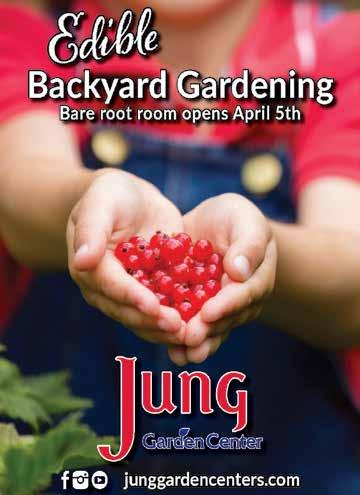




EDIBLEMADISON.COM 27


28 • SPRING 2024
A student at Nuestro Mundo Elementary School harvests sweet potatoes.

SEEDS OF CHANGE
by Erica Krug
It’s a brisk Thursday in early December and the raspberries in Spring Harbor Middle School’s garden have been dormant for several months, but they haven’t been forgotten by Dave Ropa’s seventh-grade students. As part of their “Food Science, Culture and Geography” unit, Ropa’s students have been tasked with developing a unique food product that contains two or more ingredients commonly grown at Spring Harbor, an environmental studies magnet middle school located on Madison’s west side. In addition to promotional materials, the students also must provide nutrition information for their product and investigate the food miles each ingredient travels in order to create the recipe. Tenzin Keyshong is a member of a group developing a chocolate candy bar with tart cherries and strawberries from their garden. “It’s more nutritious,” Keyshong says, “And other food might have weird pesticides in it.”
When Ropa started teaching at Spring Harbor 24 years ago all of the school grounds were mowed. Concerned about this lack of biodiversity, Ropa built a rain garden right outside his classroom. “It’s like getting a tattoo,” Ropa says. “Once you get one, you can’t stop. We just kept making gardens.” The school now has several rain gardens, a butterfly garden, a fruit orchard, a chicken coop and an acre of vegetable gardens. During the school year Ropa’s students visit the garden often. Keyshong says he appreciates this time. “In the middle of the school day you don’t [normally] get a lot of fresh air,” he says. “You might also really care about plants, and you can’t do that in a classroom.”
Spring Harbor also hosts a garden summer camp where kids get to cook, weed and tend to the chickens. James Russ, another seventh grader in Ropa’s class, has participated in the camp the past two summers. Hesitant at first—“My parents signed me up for it,” he says—he loved socializing and cutting down weeds. “My first summer I was in a thistle gang. I cut one down that was bigger than me,” he says. Russ believes gardening is an important skill that all children should have the opportunity to learn. “Kids can learn how plants work and take care of nature in general,” he says.
EDIBLEMADISON.COM 29


One of the ways that Spring Harbor students learn to care for plants is by growing food in their large vegetable garden filled with peppers, kale, squash, beets, sugar snap peas and more. Planted in the late spring and early summer, many of Spring Harbor’s seedlings, or young plants, are grown at Oakhill Correctional Institution and then donated to the school through its youth garden program.
Located just outside Madison in Oregon, Oakhill is a minimum-security prison with an emphasis on preparing its residents for release into the community by providing education and work opportunities. David Markle is a horticulture instructor who has been with the facility for six years. In addition to growing seedlings for youth garden sites, a program which began in 2014, Markle teaches a 20-week horticulture class to some of Oakhill’s PIOCs or “Persons In Our Care,” who receive a certificate from Madison College upon completion of the course. He also oversees the facility’s three greenhouses and two large vegetable gardens which produced 17,000 pounds of food last year for Oakhill’s kitchen.
Markle, who grew up in Waukesha, credits his piano teacher for introducing him to horticulture at an early age. “I started mowing lawns for her,” he says. “She had a humongous garden and her house was always on the [garden] walks. Slowly she started to teach me how to take care of it which led her to letting me design a garden for her yard.” After college Markle worked at several greenhouses before accepting the teaching position at Oakhill where he took over the program which now grows seedlings and provides them for free to 35 youth garden sites in Dane County. The project is funded entirely by donations with most of the money for supplies coming from a Mother’s Day hanging flower basket sale for Oakhill staff. One of the intentions of the program is to create awareness and appreciation for the restorative benefit that it achieves. “It’s a way for us to give back to the community and educate others,” Markle says.
Now in its 10th year, the process of starting the seedlings has become an exciting ritual that begins at the end of January when Markle and several of his horticulture students and paid workers start planting some of the 26,000 seeds—a combination of vegetables, herbs, annual and perennial flowers—that they will continue to plant weekly in Oakhill’s greenhouses through April. At first the activity takes a lot of faith for the PIOCs, many of whom don’t have any previous experience growing plants. “When you try to explain certain things, like why
is this greenhouse completely bare right now? [I say,] ‘Wait four more weeks and this will be completely full, and wait four more weeks and the plants will be three times the size they are now.’ They don’t see that initially,” Markle says. “When it happens it’s almost a panic, they aren’t used to that, and then it’s a relief when they get all of the orders out of there; you can tell that there is an accomplishment that comes with it. I think that is awesome because a lot of times when you are in prison you don’t see positives. This is a humongous positive.”
The orders Markle refers to are the plant request lists that he receives in late spring from the 35 youth garden sites, two-thirds of which are school gardens, who have established a relationship with Oakhill’s program. “We grow vegetables, herbs, annuals and perennials,” Markle says. “I think it’s important that we grow all of these because it also helps the kids learn what is going to be there this year, what won’t be there next year, and what might come back next year.” After Markle sends out a list of what is available, including about 20 different types of herbs, 60 types of vegetables—last year’s list had eight varieties of lettuce, three kinds of pumpkins and ten different tomato varieties—and 60 kinds of annual and perennial flowers, garden coordinators return their request forms and wait eagerly for mid-May when they can drive to Oakhill to pick up the plants.
Carol Troyer-Shank is the garden coordinator at Nuestro Mundo Elementary School (previously Allis Elementary) located on Buckeye Road on Madison’s east side where she says the Oakhill plants have renovated their garden. “Before that it was scrounging,” she says. “Where are we going to get the money for plants? How are we going to raise all these little seedlings, the tomatoes and the peppers and all these things? And then I found out about this program where you can pick and choose and say, ‘This is my list’ and you just go and fill up the back of your car and suddenly boom! You have a garden that you can plant! It’s really amazing.”
Troyer-Shank, who taught at Allis for years before retiring, says she loves telling the children about where the plants that they plant in late May came from. “These men made some mistakes but now they are making it right and helping the community,’” she says. “I love telling that restorative story about how you can give back because that philosophy of taking care of the land and taking care of each other is so important to me in gardening with children; that is one of the most important stories you can tell.”
30 • SPRING 2024
Top: Kids at Eagle's Wing Child Care learn how to keep their garden well watered.
Bottom: Toddlers at Eagle's Wing Child Care admire flowers in their garden.
Opposite page, left: Horticulture instructor, David Markle, in the Oakhill Correctional Institution greenhouse.
Opposite page, right: Students at Spring Harbor Middle School tend their garden, grown from seedlings donated by Oakhill Correctional Institution.
Photos courtesy of Oakhill Correctional Institution's horticulture program, Asenna Bojilova Kitina, Tera Sarow and David Ropa
Maya Kanke-Goss is a fourth-grade student at Nuestro Mundo who says she has “helped fix raised beds, made signs, planted things, pulled out weeds, and picked tomatoes,” but her favorite thing to do in the garden is pick and eat berries from the school’s strawberry and raspberry patches. She also enjoys learning about traditional Native American gardening practices. “We learned about the three sisters,” she says. “They are squash, corn and beans. They are grown together because they each help each other grow in a different way. You can do this kind of planting instead of using chemicals that are bad for the Earth.”
“I love telling that restorative story about how you can give back because that philosophy of taking care of the land and taking care of each other is so important to me in gardening with children; that is one of the most important stories you can tell.”
-Carol Troyer-Shank
While Oakhill supplies plants mainly to schools, several early-childcare centers also receive the plants in May. One of these sites is Eagle’s Wing Child Care located in Eagle Heights, a

UW–Madison housing complex with a large plot of community gardens where Asenna Bojilova Kitina is a teacher and garden coordinator. “I have always loved to be in nature, around plants and in the garden. When I was a child, I spent summers at my grandparents' house in the countryside where there was a lot of gardening and agricultural work,” Kitina says. She now loves bringing that experience to her work. “Toddlers can be actively involved in gardening, and they love it!” she says. “They can water using watering cans, they can carry weeds to the weed pile, pull smaller weeds, enjoy the flowers…It would be great if every daycare center and school could have a garden where children can go and explore, plant and observe and harvest.”
Kitina also observes how these experiences impact children’s food choices. “From my experience with young children, I can say that when you involve them in the garden, most of them are ready to try anything!” she says. She cites a chive plant located near the toddler playground as an example. “We get the toddlers to try it and we say, ‘This is chives.’ They love it, as garlicky as it is, and they learn the name before they could even say many other words and ask for chives every time we are out.” She says parents have also been surprised to learn at the end of the day that their child ate lettuce. “One time we offered the three-year-olds a salad of lettuce and plain yogurt with salt and olive oil—Bulgarian-style salad—and they loved it!”
The Oakhill plants have been integral to Eagle’s Wing’s Garden. “I don’t think we [could] have that much in our garden if it wasn't for that program,” Kitina says. “Mr. Markle and his team are constantly experimenting with new plants and varieties and every year they provide us with a great assortment of vegetables, seasonal and perennial plants.”
Kitina is grateful for the plants and knows that involving children in the garden will stay with them their whole lives. “I believe that when someone, child or an adult, gets engaged in gardening and plants something, watches it grow and harvests it, then they start to appreciate the food even more. Homegrown food is tastier and dearer,” she says.
Troyer-Shank echoes Kitina in her appreciation for the Oakhill plant program because she believes gardening with children is one of the most important things you can do. In a world of immediate gratification which is not in tune with nature, gardening “teaches patience,” Troyer-Shank says. “It teaches real-time hopefulness… It’s really important for [children] to learn about the seasons of waiting and hoping and caring and enjoying and then waiting and hoping and caring and enjoying again. It’s really an important cycle.”
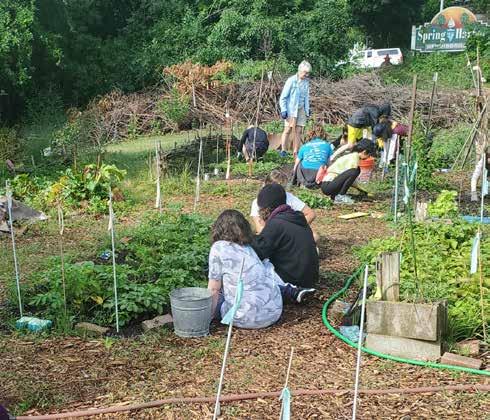
EDIBLEMADISON.COM 31








32 • SPRING 2024 Come visit and enjoy our popular old fashioneds, steaks and seafood! Located in Spring Green on Hwy 14 4pm, Lounge Opens • 4:30pm, Service Begins Convenient Drive-up Window Wednesday—Sunday Reservations suggested for weekend dining. Call 608-588-2521. Browse our menu at arthurssupperclub.com 58965 Lucky Lane • Eastman, WI 54626 LATARNIAGUESTHOUSE.COM ® Gift & Garden Store, Gardens, Trails & More Visitors Center open March-October 10am to 5pm | 7 days a week 3074 N Winn Rd, Decorah, IA 52101 563.382.5990 · seedsavers.org/visit ONSITE AND VIRTUAL EVENTS seedsavers.org/ events OPENING MARCH 1! Lillian Goldman Visitors Center
You already eat farm-to-table. Why not imbibe locally too? Try these Wisconsin beverage makers for some of the most creative refreshments around.
BAILEY’S RUN VINEYARD & WINERY
Bailey’s Run is open seven days a week with Neapolitan pizzas and live music every weekend.
BAILEYSRUNVINEYARD.COM baileysrunvineyardandwinery baileysrunvineyard
BALANCED ROCK WINERY
Family-owned boutique winery located on the doorstep of Devil’s Lake State Park. Stop in for wine, food, beer and music.
BALANCEDROCKWINERY.COM balancedrockwinery balancedrockwinery
BRIX CIDER
Every bite and every sip at Brix Cider in Mount Horeb supports the beautiful and bountiful community in which they reside.
BRIXCIDER.COM brixcider brixcider

THE CIDER FARM
Small-batch, family-owned and certified organic orchard growing English and French cider apples in Mineral Point for local cider and apple brandy.
THECIDERFARM.COM the_cider_farm theciderfarm
SUNSHINE BREWING COMPANY
Lake Mills brewery offering a wide variety of handcrafted beers, including a range of delicious Belgian-inspired brews and mouthwatering Mexican cuisine that pairs perfectly.
SUNSHINEBREWCO.COM sunshinebrewco sunshinebrewco
DANCING GOAT DISTILLERY
Located 20 miles east of Madison in Cambridge, Dancing Goat Distillery is open for tours, tastings and a gin academy where guests craft their own bottle of gin.
DANCINGGOAT.COM dancinggoatdistillery dancinggoatdistillery
HERBIERY BREWING
LGBTQ+ owned brewery specializing in hop-free, herb- and spice-based beers brewed with the highest quality ingredients. Now with a taproom in the Atwood neighborhood.
HERBIERY.COM herbiery herbiery
RUDE BREW KOMBUCHA
Small, craft kombucha brewery that utilizes locally grown fruits and herbs to flavor their brews. Now located in the Willy Street neighborhood in Madison.
RUDEBREWKOMBUCHA.COM rude_brew_kombucha rudebrewkombucha
Local Craft Beverages


And CSA is about more than just food. In addition to regularly receiving a delicious box of farm-fresh food all season long, having a personal relationship with your farmer allows you to learn the story behind your food, who grows it, and how. And by signing up in advance, your farmer is better able to plan for the season ahead.
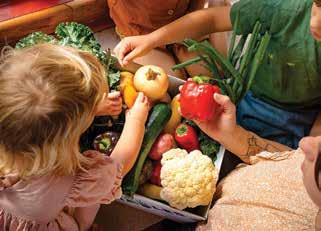
Along with farm-fresh food, CSA members often also receive:
• News from the farm, including notes about what’s in each box, cooking tips, and recipes.
• Opportunities to visit the farm and attend farm events.
• Payment plans or financial support to accommodate households on a tight budget.
• The knowledge that your farmer uses sustainable and organic farming practices that limit environmental impact.

FIND A FARM STEP 1. STEP 2. STEP 3. • Pickup location • Share Type
Community Supported Agriculture (CSA) is a way to buy local food directly from a farmer by purchasing a “share” of the farm’s products at the beginning of the season and receiving the bounty of the harvest throughout the growing season.
Go to: csacoalition.org/farm-search Choose the CSA share that is right for you using our Online Farm Search Tool Search FairShare Endorsed farms using the criteria that matters most to you: Explore your results, choose your farm, and get ready for delicious farm-fresh food! • Season • Share Size
Grown for
JOIN A CSA Food
You

Blue Roof Orchard
Chris & Juli McGuire
Belmont, WI
www.bluerooforchard.com
@BlueRoofOrchard
Established 2003
We are the area’s only apple CSA, delivering flavorful and unique organic apples in autumn to the greater Madison area, Platteville, and Viroqua. We share pick up sites with veggie CSAs, so you can pick up apples and veggies at the same time.

Harmony Valley Farm
Richard de Wilde & Rafael Morales
Peralta
Viroqua, WI
harmonyvalleyfarm.com
@harmonyvalleyfarm
Established 1984
Offering a long delivery season from May to December along with over 30 years of experience growing for CSA families.
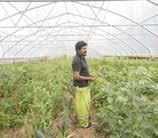
Los Jalapeños CSA
Juan Gonzalez Torres
Verona, WI
farleycenter.org/farming/ csa-farmers-markets
Established 2011
Juan Gonzalez Torres grows veggies for his CSA at the Farley Center for Peace and Justice. For over 20 years he has used skills honed on his family farm in Puebla, Mexico to grow both traditional crops for the Madison area as well as Mexican specialty crops like squash blossoms, pápalo, and tomatillo.

Small Family Farm
Jillian & Adam Varney
La Farge, WI
smallfamilycsa.com
@smallfamilycsafarm
Established 2006
Small Family Farm is committed to being stewards to the land and delivering fresh, organic vegetables to our community.

Steadfast Acres
Elisabeth Minich & Steven Shoemaker
Lone Rock, WI
steadfast-acres.com
@steadfastacres
Established 2018
Steadfast Acres focuses on quality produce and ease of use! We offer several customizable share options.
FARM SPOTLIGHTS

Crossroads Community Farm
Cassie Wyss & Michael Noltner
Cross Plains, WI
crossroadscommunityfarm.com
@crossroadscommunityfarm
Established 2005
Crossroads Community Farm grows and delivers customizable organic vegetable shares so every meal tastes fresh.

Keewaydin Farms
Rufus Haucke & Joy Miller
Viroqua, WI
keewaydinfarms.com
@keewaydinfarms_organic
Established 2004
Our 200-acre farm has been providing certified organic food for 100+ CSA members since 2004 and we take special pride in stewarding our land for both our human friends and most vulnerable animal species.

Lovefood Farm
David & Abby Bachhuber Stoughton, WI
lovefoodfarm.com
@lovefoodfarm
Established 2015
Lovefood Farm is located on 30 acres of beautiful rolling land in the town of Pleasant Springs, about 25 minutes east of Madison. We (David, Abby and our daughter Soleia) grow 5 acres of vegetables and herbs that are devoted to our CSA as well as sales to local farmers markets, restaurants and grocery stores.

Squashington Farm
Sarah Leong & Patrick Hager Mount Horeb, WI
squashingtonfarm.com
@squashingtonfarm
Established 2016
100-member CSA in Mount Horeb offering pre-packed and market-style shares. On farm pick ups and Madison drop sites.

FairShare Endorsed




36 • SPRING 2024
while-you-wait sharpening of knives, scissors, and garden tools any day but Sunday 3236 B University Ave, Madison, WI 53705 · wisconsincutlery.com
Photo by SV Heart Photography
BY MARISSA DEGROOT

AHAN: A RISING RESTAURANT STAR
“I don’t look at those lists. I didn’t even know that’s what people do.”
As it turns out, a lot of people were tuned in on January 25, 2023 when the James Beard Foundation announced the semifinalists for its Restaurant and Chef Awards. Jamie Brown-Soukaseume was not one of those anxiously awaiting the breaking news.
EDIBLEMADISON.COM 37
The executive chef and co-owner of Ahan learned she had been nominated for a James Beard Award in the Emerging Chef category through a congratulatory text message from a former restaurant regular. Jamie was stunned. Being selected as a candidate for one of the most prestigious culinary awards caught Jamie completely by surprise, but the subsequent growth of her fame and restaurant came as a shock to no one who had ever tasted her food.
“A lot changed when Jamie got nominated. We were always really busy, but then it became [un]sustainable in [that] location.”
—Chuckie Brown-Soukaseume
Last October, Jamie, along with husband and co-owner, Chuckie Brown-Soukaseume, moved their Laotian restaurant Ahan, to a new, larger space on Madison’s Williamson Street from their former location at the Bur Oak event venue. “A lot changed when Jamie got nominated,” said Chuckie. “We were always really busy, but then it became [un] sustainable in [that] location.”
Clockwise from upper right: Executive chef and co-owner of Ahan, Jamie BrownSoukaseume, finishes a dish in the kitchen of her Willy Street restaurant.
A bowl of khoa poon kathi dang, a coconut red curry soup with roasted chicken and rice noodles, makes its way to the dining room.
Lead line cook, Jose-Luis Cardenas, manages dishes from noodles to curry in the Ahan kitchen. Jamie checks a ticket alongside a to-go order of khao tod, deep-fried rice, imitation crab, red curry and lemongrass.


38 • SPRING 2024
Photos by SV Heart Photography


EDIBLEMADISON.COM 39

The couple had plenty of experience scaling up their operation from its humble beginnings in early 2020. “We had just secured a very tiny food cart and started doing pop-ups at the Robin Room,” said Chuckie. With lines down the street from the bar, they quickly knew they were going to have to think bigger. They moved into the (not much) larger kitchen of the Bur Oak in August of that year and over the next three years became one of Madison’s favorite takeout spots.
Transitioning from primarily takeout to a large restaurant space has been relatively smooth for the seasoned duo, thanks in part to the two culinary legacies Jamie has inherited—one through her family and the other through her culinary family. “I’ve been in the restaurant industry my whole entire life… since I was three,” says Jamie. Her mother Manola Hoang, a chef herself for 35 years, had left Laos during the Vietnam War. She brought her skills and family recipes to Wisconsin—first at her Chinese American restaurant in La Crosse and later at Madison’s Ha Long Bay, owned by Jamie’s aunt. When Jamie and Chuckie opened
Ahan, Hoang was right by their side, working together with her daughter to capture authentic Laotian flavors, utilizing recipes handed down through the generations with local ingredients.
Dishes like their pho, khao soi and papaya salad are Hoang’s own recipes which Jamie grew up eating. The khao soi luang prabang is a dish passed on by Jamie’s grandmother, featuring wide or rice noodles in chicken broth, ground pork, tomato, fermented soybean and chili. Jamie’s menu draws inspiration from her past as well as the abundance from area farms like Enos Farms, Stack Farms and Food Co., Vitruvian Farms, Garden To Be and Bee Charmer.
After hours of steeping and cooking to develop flavors, Jamie takes these dishes and presents them with modern plating techniques—techniques honed over the years working in Tory Miller’s kitchens. A James Beard Award winner himself, the executive chef and co-owner of L’Etoile and Graze on Madison’s capitol square hired a 20-year-old Jamie right after she graduated from the Madison College culinary arts program.
Jamie’s time at L’Etoile, Estrellón and Sujeo allowed her to work alongside chefs like Tory and his teams who provided much more than just culinary experience. “They’re so creative, passionate, hardworking,” said Jamie. “They are really people you can look up to.”
As Jamie looks to some Madison greats for inspiration, she herself is becoming a culinary icon in a city known for its talented chefs and dynamic restaurant scene. Jamie joins a list of over 10 Madison chefs to win or be nominated for a James Beard Award in the past 10 years. That recognition may be what brings some initially to Ahan, but it’s the deep, vibrant flavors along with the care of an incredible team that’s keeping tables packed night after night.
Guests enjoy a
40 • SPRING 2024
Top:
variety of Laotian and Southeast Asian dishes at Ahan's new restaurant space with a much expanded dining room.
Top right: Chuckie Brown-Soukaseume, Ahan co-owner, chats with diners as they dig in to some restaurant favorites, including the nam khao salad with house-made panang curry sausage.
Bottom right: Ethan Ha skillfully balances dishes for hungry diners, including a bowl of pho gai, bone broth, roasted chicken and rice noodles with plenty of fresh veggies and herbs.
Photos by SV Heart Photography
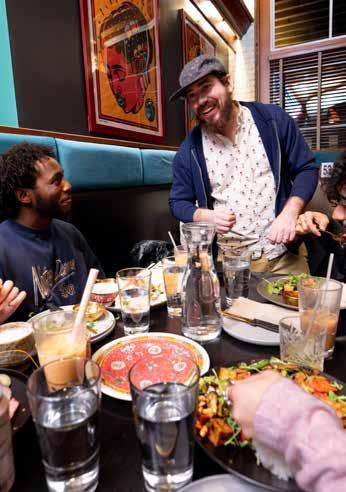



Enjoy farm-to-table dining in a lovingly restored dairy factory! Discover the charm of Paoli, Wisconsin.

Mention this ad for a free welcome old fashioned when you dine at The Kitchen at Seven Acre. Restaurant, Cafe,

EDIBLEMADISON.COM 41 AN OLD-FASHIONED WELCOME, A WELCOME OLD FASHIONED.
& Boutique Hotel | sevenacredairy co.com












































































is a network of magazines across the U.S. and Canada edible BOZEMAN Telling the Stories of Local Food & Drink Member Edible Communities WOLDY REYES edible Cape Cod edible east end ISSUE ROMILLY NEWMAN PARTY THE The future of food MILK & HONEY Celebrating 10 years Holiday Feasts Local Meat Fall/Holiday 2023 edible PHILLY GET WET Where to Swim, Spa, the land the sea ~ the people ~ the food edible M aritimes Wild Finds edible newfoundland & labrador the land ~ the sea ~ the people ~ the food Asparagus Marilyn Schlossbach Grape Debate CSAs Restaurant Guide Spring Destinations edibleJersey We are part of something bigger! Scan to learn more
Eat & Drink Guide
When you're thinking of going out to explore a new place to eat or meet friends for drinks please consider these generous sponsors.

A woman-owned natural winery in the heart of the Driftless region. Wines are available at our tasting room, or to ship nationwide.
802 Ridge Street, Mineral Point AMERICANWINEPROJECT.COM

Forage Kitchen crafts specialty salads, hearty grain bowls, and soups crammed with mouthwatering, wholesome, local ingredients that keep you happy and satisfied all day long.

A country roadhouse serving burgers made from locally-grown beef and other local fare. The Friday night fish fry, wood-fired pizza nights and smoked rib nights are not to be missed!
132
A cozy, upbeat spot to grab delicious, ethically sourced coffee and other specialty drinks. Thoughtfully developed breakfast and lunch menus highlight local goods.
815

A spacious lounge offering cocktails, brunch, local brews, upscale bar fare (including vegan and gluten free options), and regular live music inside the historic Garver Feed Mill five days a week.
3241 Garver Green, Madison GARVEREVENTS.COM/LOUNGE

A neighborhood bar and bistro with great cocktails, 22 draft lines, and a seasonally inspired menu. Join us for Happy Hour Monday-Friday!
1923 Monroe

242
farbretonbakery.com
A one-of-a-kind bakery specializing in handcrafted, all-butter croissant creations available at their storefront as well as the Dane County and Northside farmers’ markets.
1924

We’re an independent, woman-owned and operated, certified organic craft brewery. We brew big, flavorful organic beers that make a positive impact on our community and the environment.
931 E Main St, Ste 9, Madison GIANTJONES.COM



Bringing the flavors of the Southwest to the Midwest with time-honored recipes. Madison’s favorite margarita! Gathering with friends for over thirty-five years.
6712 Frank Lloyd Wright Ave #102, Middleton

134
102
44 • SPRING 2024
S Main St, Lime Ridge BRANDINGIRONRH.COM
Fordem Ave, Madison FARBRETONBAKERY.COM
Locations Across Madison EATFORAGE.COM
Ave,
LETSSHINECOFFEE.COM
Water
Hillsboro
St, Madison ONEANDONLYWI.COM
Cross Country Rd, Verona
100
PASQUALSCANTINA.COM
Locally focused casual fine dining, natural wine, fun cocktails, family friendly, outdoor garden, and playground.
Locally focused fine dining, great wine, and a full bar in a beautiful historic building.
The downtown destination for great corner tavern food featuring an ever-changing selection of craft beers and a wonderful outdoor patio.
Lexington Street, Spring Green HOMECOMINGSPRINGGREEN.COM
W Jefferson Street, Spring Green REUNIONSPRINGGREEN.COM
King St, Madison TIPSYCOWMADISON.COM
E S T 2 0 MADISON SUN PRAIRIE
Tipsy Cow
Want to see more resources?
Check our local guide online: ediblemadison.com/local-guide

An authentic slow-food restaurant featuring the unique flavors of cast-iron cooking in a wood-fired oven. Serving local meats, seasonal vegetables, fresh seafood, handmade desserts, fine wines, cocktails and craft beers.
206 Center Street, Wonewoc FARMHEARTHBISTRO.COM

A step back in time, this speakeasy and beer garden located in a boutique hotel offers Prohibition- style drinks, local wine and brews, mocktails, and small plates.
21 S State St, Mazomanie IRONAMETHYST.COM

A restaurant, market, meal kit service, and event space serving a locally-sourced daily menu to folks who are hungry for high-quality, healthy meals, but starved for time.
2433 University Ave, Madison PASTUREANDPLENTY.COM

A restaurant, market, meal kit service, and event space serving a locally-sourced daily menu to folks who are hungry for high-quality, healthy meals, but starved for time.
27 W Main, Madison
117 Rittenhouse Ave, Bayfield 302 S Main, Viroqua WONDERSTATE.COM

EDIBLEMADISON.COM 45 REAL FOOD. REAL LOCAL. FARM-TO FREEZER stock
COOK FRESH
CURBSIDE PICK-UP
up on frozen favorites
weekly meal kit delivery and pick-up
order from our menu online (air-fives included)
eating
2433 University Avenue | pastureandplenty.com Making eating well and
local a little easier every day.
THANK YOU TO OUR ADVERTISERS!
We would not exist without the support of the businesses and organizations that advertise in our pages. This support allows us to pay writers, designers, photographers, print and distribute this issue and make this a free publication for readers to pick up throughout southwestern Wisconsin.
Please support the following businesses to experience the best local, seasonal and sustainable products and services in the region.
If you enjoy this publication and want to support our work, please consider subscribing. An added bonus: you won't miss an issue. Subscribe at ediblemadison.com.
Thank you!
GROCERY STORES & FARMERS' MARKETS
PEOPLE’S FOOD CO-OP www.pfc.coop
VIROQUA FOOD CO-OP viroquafood.coop
WANDER PROVISIONS wanderprovisions.com
WILLY STREET CO-OP willystreet.coop
LIFESTYLE & KITCHEN GOOD DAY SHOP gooddayshop.net
SIFT & WINNOW siftandwinnow.com
WISCONSIN CUTLERY & KITCHEN SUPPLY wisconsincutlery.com
HEALTH & WELLNESS
CONSCIOUS PRACTICE conscious-practice.com
TELSAAN TEA telsaan.com
EVENTS
COOKING TOGETHER!
PIZZA WITH PURPOSE ediblemadison.com/events/ pizza-with-purpose RIDGES & RIVERS BOOK FESTIVAL ridgesandriversbookfestival.org
WISCONSIN GRILLED CHEESE CHAMPIONSHIP grilledcheesewisconsin.com
TOURISM
IRON AMETHYST INN & THE 2ONE SPEAKEASY ironamethyst.com
LATARNIA GUEST HOUSE latarniaguesthouse.com
OLBRICH BOTANICAL GARDENS olbrich.org
VISIT SHEBOYGAN visitsheboygan.com
FARMS & FOOD GOODS
DOUDLAH FARMS doudlahfarms.com
DRIFTLESS CHOCOLATES driftlesschocolates.com
HIDDEN SPRINGS CREAMERY hiddenspringscreamery.com
MEADOWLARK FARM & COMMUNITY MILL meadowlarkorganics.com
ORGANIC PRAIRIE organicprairie.com
RIEMER FAMILY FARM riemerfamilyfarm.com
VITRUVIAN FARMS vitruvianfarms.com
HOME & GARDEN
JUNG GARDEN CENTER junggardencenters.com
SEED SAVERS EXCHANGE seedsavers.org
FOOD, AGRICULTURAL & SUSTAINABILITY ORGANIZATIONS
FAIRSHARE CSA COALITION csacoalition.org
SAVOR THE RIVER VALLEY savortherivervalley.org
FOOD & BEVERAGES
AMERICAN WINE PROJECT americanwineproject.com
ARTHUR’S SUPPER CLUB arthurssupperclub.com
BAILEY’S RUN VINEYARD baileysrunvineyard.com
BALANCED ROCK balancedrockwinery.com
BRANCH & DAUGHTER branchanddaughter.com
BRANDING IRON ROADHOUSE brandingironrh.com
BRIX CIDER brixcider.com
THE CIDER FARM theciderfarm.com
THE COOPERS TAVERN thecooperstavern.com
DANCING GOAT DISTILLERY dancinggoat.com
DRUMLIN RIDGE WINERY drumlinridgewinery.com
D’VINO dvinomadison.com
EMMI ROTH CHEESE rothcheese.com
FAR BRETON BAKERY farbretonbakery.com
FARM HEARTH & BISTRO farmhearthbistro.com
FORAGE KITCHEN eatforage.com
GARVER LOUNGE garverevents.com/lounge
GIANT JONES giantjones.com
HERBIERY BREWING herbiery.com
HOMECOMING homecomingspringgreen.com
ISLAND ORCHARD CIDER islandorchardcider.com
LET’S SHINE COFFEE letsshinecoffee.com
LOMBARDINO’S lombardinos.com
LONGTABLE BEER CAFE longtablebeercafe.com
MADISON SOURDOUGH madisonsourdough.com
ONE & ONLY oneandonlywi.com
PASQUAL’S CANTINA pasqualscantina.com
PASTURE & PLENTY | P&P MAKESHOP pastureandplenty.com
REUNION reunionspringgreen.com
RUDE BREW KOMBUCHA rudebrewkombucha.com
SEVEN ACRE DAIRY sevenacredairyco.com
SUNSHINE BREWING CO. sunshinebrewco.com
TIPSY COW tipsycowmadison.com
WONDERSTATE COFFEE wonderstatecoffee.com
PETS
THE PETINARY CLINIC petinaryclinic.com
46 • SPRING 2024












EDIBLEMADISON.COM 47 Private Rental Space for Small Gatherings Winery Tours & Gift Shop Visit local farms and food businesses, meet farmers and food processors, enjoy delicious food, and shop local products. MAP & DETAILS: SAVORTHERIVERVALLEY.ORG/EVENTS Get behind the scenes on April 20! FA R M & FOOD TOUR 10 A.M. – 4 P.M. Just a short drive from Madison! The Petinary PETINARYCLINIC.COM 608-255-1239 1014 Williamson St, Madison,WI Order at RiemerFamilyFarm.com Offering convenient home delivery to the Madison area every week. Taste the difference of local, regenerative, grass-fed meats today. Brodhead, WI 608-897-6295
sheep make the best cheese. Award-winning, healthy, and environmentally friendly artisanal cheeses produced by our family in the beautiful Driftless region.
Happy
HIDDENSPRINGSCREAMERY.COM
WESTBY, WISCONSIN


48 • SPRING 2024 SPRING 2024 RECIPE INDEX SWEET Zucchini Bread ...................... 23 SAVORY Glazed Baby Carrots with Carrot-Top Pesto on HerbWhipped Greek Yogurt ............... 6 Watercress and Chévre Stovetop Frittata 12 Chicken and Pineapple Spring Fried Rice 22 Spring Green Meatballs with Marinara 25 Spring Rolls .......................... 26 MORE SEASONAL RECIPES ONLINE Check out our recipe archive online and sign up for our monthly e-newsletter to get fresh meal inspiration in your inbox. EDIBLEMADISON.COM/RECIPES Cream of Nettle Soup Rice Salad with Asparagus Upside-Down Rhubarb Olive Oil Cake local and organic seeds and garden starts, native prairie plants and more 609 N Main St, Viroqua • open daily • viroquafood.coop LA COSECHA TART LES DELICES DE AWA ICE CREAM SOCIAL PASTURE & PLENTY MADISON CHEESE BOARDS GET A TASTE OF THE FOLLOW ALONG @ PANDPMAKESHOP SIGN UP FOR NEWSLETTERS PASTUREANDPLENTY.COM

Come spring, a certain colorful magic emerges from the ground tucked in a little valley near downtown Mount Horeb. Magic in the form of endless varieties of flowers, hand selected by husband and wife duo, Lisa and Hans Larsen. Together they run the flower farm and design studio Sunborn Gardens, started by Hans’s mother Carol in 1975. Their love affair with flowers began at the Dane County Farmers Market where they have been a vendor for 49 years and continues with curating wedding design plans, from modern floral installations to a la carte blooms.
“When the opportunity to take over the family farm business came up I had just had my first child,” writes Hans. “It was in that moment that I knew I had to do it. I wanted my daughter to live the magical nature filled life I had as a kid. I wanted her to play in those woods and talk to the flowers.” The magic abounds…
EDIBLEMADISON.COM III
EMILY KAUFFMAN
Photo by Ope Visco













 Cheers, Marissa DeGroot, Managing Editor
Cheers, Marissa DeGroot, Managing Editor






























































 Recipe by Chelsea Chandler and Scott Laeser of Plowshares & Prairie Farm
Recipe by Chelsea Chandler and Scott Laeser of Plowshares & Prairie Farm

 Recipe by Ian Gurfield of Ian’s Pizza & Susan Detering of Batch Bakehouse
Recipe by Ian Gurfield of Ian’s Pizza & Susan Detering of Batch Bakehouse


 Recipe by Tory Miller of Graze and L’Etoile
Recipe by Tory Miller of Graze and L’Etoile





























































































































































